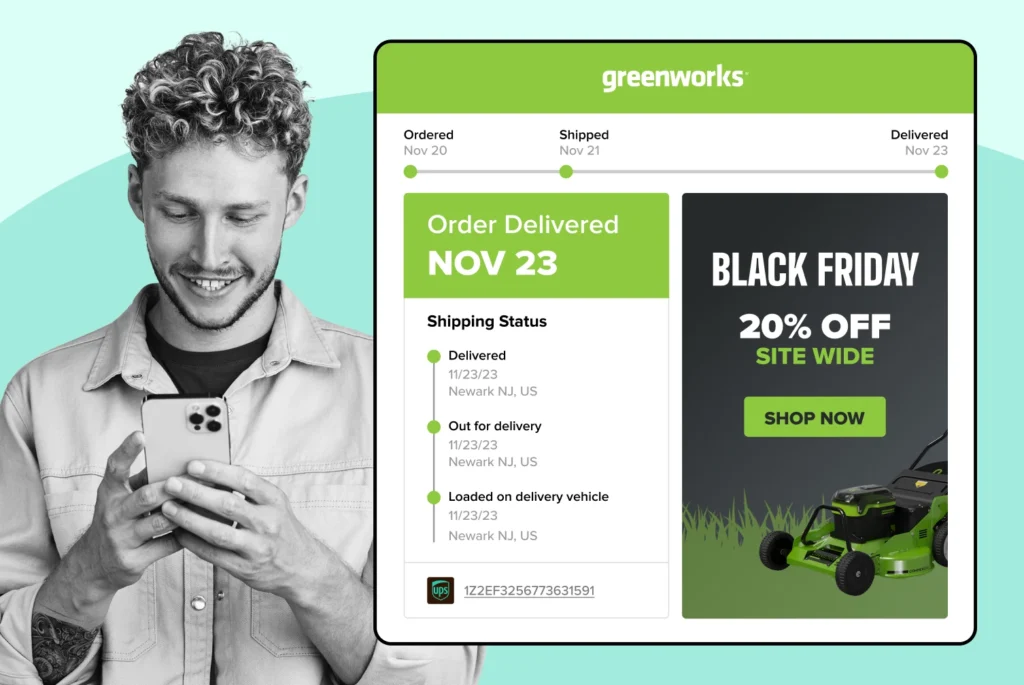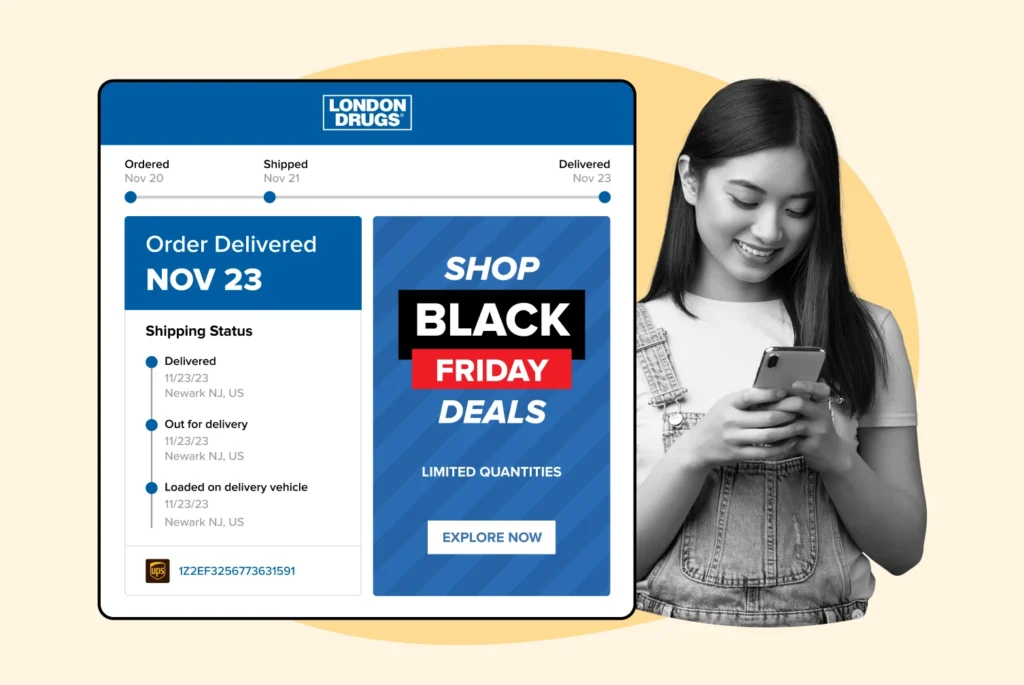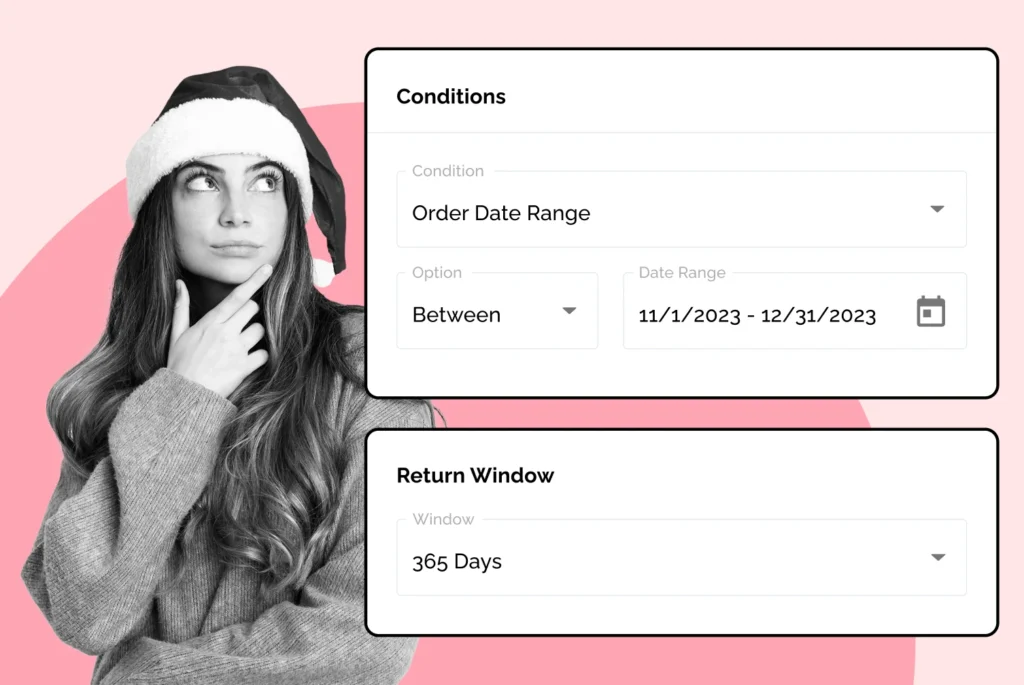
How Returns Impact Peak Season
Let’s discuss how effective return management is crucial during peak seasons and provide strategies to handle returns efficiently!
Shipping, Tracking & Notifications
Boost customer experience and reduce support tickets
Realtime order and shipment tracking
Proactive order and shipping notifications
AI-Enhanced Discounted Labels
Predictive pre-purchase estimated delivery dates
Self-Serivce branded order tracking
Effortless experience delivered
Identify and Resolve Order Issues
Realtime order and shipment tracking
Make returns profitable and delight customers
Flexibility to define any return destinations & conditions
Simplify returns for your customers and team
Incentivize exchanges over returns
Returns management made easy for your team
Returns management made easy for your team
Easy claims and smart upsells
Understand why your customers are returning
In-Store & Curbside Pickup
Unify the online and the in-store experience
Hassle-free pickup experience for customers
In-Store dashboard to keep operations streamlined
In-Store and Online orders unified
Drive foot-traffic to your stores
Shipping, Tracking & Notifications
Boost customer experience and reduce support tickets
Realtime order and shipment tracking
Proactive order and shipping notifications
AI-Enhanced Discounted Labels
Predictive pre-purchase estimated delivery dates
Self-Serivce branded order tracking
Effortless experience delivered
Identify and Resolve Order Issues
Realtime order and shipment tracking
Make returns profitable and delight customers
Flexibility to define any return destinations & conditions
Simplify returns for your customers and team
Incentivize exchanges over returns
Returns management made easy for your team
Returns management made easy for your team
Understand why your customers are returning
In-Store & Curbside Pickup
Unify the online and the in-store experience
Hassle-free pickup experience for customers
In-Store Dashboard to keep operations streamlined
In-Store and Online orders unified
Drive foot-traffic to your stores
Boost customer experience and reduce support tickets
Realtime order and shipment tracking
Proactive order and shipping notifications
AI-Enhanced Discounted Labels
Predictive pre-purchase estimated delivery dates
Self-Serivce branded order tracking
Effortless experience delivered
Make returns profitable and delight customers
Flexibility to define any return destinations & conditions
Simplify returns for your customers and team
Incentivize exchanges over returns
Returns management made easy for your team
Equip your team for precise return checks.
Easy claims and smart upsells
Understand why your customers are returning
Unify the online and the in-store experience
Hassle-free pickup experience for customers
In-Store Dashboard to keep operations streamlined
In-Store and Online orders unified
Drive foot-traffic to your stores
Find the answer to all your questions
Take a step by step trip through our functionality to see how we can improve your ecommerce processes.
Explore the most comon questions about WeSupply
Calculate the ROI that WeSupply can bring you
Read actionable articles on how to optimize your post-purchase experience and decrease support tickets
Get inspired by stories of how our customers implemented an effortless post-purchase experience
Wondering if WeSupply is a good fit for you? Read through our use cases to see how we can help you increase conversion & improve CX!
A Deep Dive into Top Companies' Order Tracking & Returns Strategy
Find the answer to all your questions
Explore the most comon questions about WeSupply
Calculate the ROI that WeSupply can bring you
Request a no strings attached review of your current shopping experience and missed conversion opportunities
Take a step by step trip through our functionality to see how we can improve your ecommerce processes.
Read actionable articles on how to optimize your post-purchase experience and decrease support tickets
Get inspired by stories of how our customers implemented an effortless post-purchase experience
A Deep Dive into Top Companies' Order Tracking & Returns Strategy
Wondering if WeSupply is a good fit for you? Read through our use cases to see how we can help you increase conversion & improve CX!

Are you worried that your returns policy might be hurting your bottom line? In this article, we explore the potential ways your returns policy could be negatively impacting your profits and what you can do to mitigate these effects. From customer satisfaction to inventory management, a poorly managed returns policy can have far-reaching consequences. Read on to learn how to assess and refine your returns process to ensure it supports both your business and your financial goals—because is your returns policy hurting your bottom line?
A clear and customer-friendly returns policy enhances trust, boosts sales, and differentiates a brand in the competitive e-commerce market.
Streamlined returns processes, supported by technology and transparent guidelines, significantly improve customer satisfaction and drive repeat purchases.
Proactively managing returns by encouraging exchanges and using customer feedback for product improvement can transform returns from a cost into a revenue retention strategy.
WeSupply can enhance your returns policy by routing items efficiently, reducing unsold stock, and cutting costs. Our solutions include flexible return policies, seamless processing, and advanced technology for optimal inventory management. Get started with WeSupply to improve your returns and boost your bottom line!
A returns policy is more than just a set of rules; it is a cornerstone of customer satisfaction and loyalty. For e-commerce businesses, it provides a safety net for customers, reducing their hesitation to make purchases. Clear return guidelines significantly enhance the shopping experience, making customers feel valued and understood.
A well-defined returns policy can deter fraudulent activities by outlining specific limits and requirements, protecting businesses while maintaining customer-friendliness. This balance is crucial for both the business and the customer, ensuring a fair and trustworthy transaction.
Effective returns policies streamline operations by optimizing processes and improving inventory management. When customers know exactly what to expect, it reduces the back-and-forth communication and speeds up the entire process. This efficiency not only saves time but also enhances the overall customer experience.
About 67% of potential customers check the store’s return policy and refund policy before making a purchase. This statistic highlights the direct impact of a store’s return policy on sales and customer trust. A vague or complicated policy can deter potential buyers, while a clear and fair policy can encourage them to complete their purchase with confidence.
In the competitive landscape of e-commerce, having a robust returns policy is not just a good-to-have but a necessity. It can set a business apart from its competitors, building a loyal customer base that values transparency and reliability. As we delve deeper into the nuances of returns policies, it becomes clear that such a policy is integral to maintaining profitability and sustaining long-term business success.
A well-defined returns policy enhances customer trust and influences purchase decisions. A clear and straightforward return policy boosts customer confidence, increasing purchase likelihood. Conversely, a vague or unfavorable return policy can discourage potential buyers, leading to lost sales.
Transparent return guidelines prevent confusion and dissatisfaction. Customers want to know exactly what to expect if they need to return a product. Clear terms, such as timeframes and conditions, significantly enhance customer confidence and trust. This clarity not only improves the customer experience but also sets realistic expectations, reducing the likelihood of disputes.
A flexible returns policy can differentiate a brand in a crowded market. Brands with accommodating return options are viewed favorably by consumers. This flexibility can be a deciding factor for shoppers choosing between similar products from different brands.
Meeting customer expectations through a well-crafted returns policy drives satisfaction and loyalty. Customers assured of easy returns or exchanges are more likely to purchase and return for future buys. This positive cycle not only boosts sales but also enhances customer lifetime value.
In essence, a returns policy is not just about managing returns but about building a trustworthy relationship with customers. Addressing customer expectations and providing a seamless return experience fosters loyalty and drives long-term success. As we move forward, we’ll explore how a good return policy can further boost customer loyalty and satisfaction.
Customer loyalty and satisfaction are the cornerstones of a successful business, and a good return policy plays a pivotal role in nurturing these elements. Implementing an easy and hassle-free return process can significantly enhance customer retention and loyalty. Straightforward return processes encourage repeat purchases, ensuring steady revenue.
92% of customers are more likely to make repeat purchases if the returns process is convenient. This statistic underscores the importance of a smooth return experience in driving customer satisfaction and loyalty. A positive returns experience not only satisfies the customer but also builds a stronger relationship with the brand, encouraging them to return for future purchases.
Customers with hassle-free return experiences are more likely to recommend the brand. Word-of-mouth referrals are valuable due to their built-in trust and credibility. Satisfied customers become brand advocates, spreading positive reviews and attracting new customers, which can significantly boost a business’s growth.
Loyal customers also tend to spend significantly more than new customers, highlighting the economic advantage of retaining them. Flexible return options foster higher customer loyalty and repeat business. This approach not only enhances revenue but also builds a loyal customer base that values the brand’s commitment to customer satisfaction.
In summary, a good return policy is essential for maintaining customer satisfaction and loyalty. It creates a positive customer experience, encourages repeat business, and generates valuable word-of-mouth referrals. As we continue, we’ll see how returns policies can also help in managing customer feedback and avoiding negative reviews.
Negative reviews can significantly impact a business’s reputation and sales, making it crucial to manage customer feedback effectively. A well-defined returns policy can mitigate the impact of negative feedback by demonstrating a company’s commitment to customer satisfaction. When customers see that a business has a clear and fair returns policy, they are more likely to trust the brand and feel valued.
Customers are more inclined to trust businesses with transparent and fair returns policies, which can lead to positive customer relationships. This trust is essential for maintaining a positive brand image and encouraging repeat business. Responding promptly to negative reviews and addressing customer concerns through a straightforward returns process reflects positively on the business’s commitment to customer satisfaction.
Implementing a user-friendly returns process can help convert dissatisfied customers into advocates for the brand. Addressing concerns and providing a seamless return experience can turn a negative situation into a positive one. This proactive approach not only resolves the immediate issue but also builds long-term customer loyalty.
A flexible returns policy allows businesses to proactively address customer concerns, reducing the likelihood of public complaints. By offering solutions that meet customer needs, businesses can prevent negative reviews and maintain a positive online reputation. This approach is crucial in today’s digital age, where online reviews can significantly influence potential customers.
In essence, a well-crafted returns policy is a powerful tool for managing customer feedback and avoiding negative reviews. It demonstrates a business’s commitment to customer satisfaction, builds trust, and fosters positive customer relationships. Next, we’ll explore how an effective returns policy can also benefit inventory management by reducing unsold stock.
Effective inventory management is critical for maintaining profitability, and a well-structured returns policy can play a significant role in reducing unsold stock. Implementing an effective returns policy can lower the volume of unsold stock by enhancing inventory management practices. When businesses manage returns efficiently, they can quickly restock and resell returned items, minimizing losses.
Accurate product descriptions and size guidance can lead to a decrease in return rates, thus reducing excess inventory. Providing detailed and accurate information helps customers make informed decisions, reducing the likelihood of returns due to mismatched expectations. This approach not only improves customer satisfaction but also optimizes inventory levels.
A well-structured returns policy that limits return periods can positively affect resale opportunities for returned items. Clear return timeframes ensure returned products are still in demand and can be resold quickly. This practice helps maintain a healthy inventory turnover and reduces the risk of overstock.
Overstock and obsolete products are often caused by inaccurate demand forecasting, which can be mitigated by a robust returns policy. Analyzing return data provides insights into customer preferences, allowing for adjusted inventory planning. This approach maintains optimal stock levels and reduces obsolete products.
The fashion industry, in particular, experiences higher return rates compared to other sectors, making effective returns management crucial for reducing unsold items. Businesses in this industry can benefit significantly from a well-crafted returns policy that addresses the specific challenges of high return rates.
WeSupply’s Intelligent Dispositions can significantly enhance inventory management by optimizing the handling of returned items. This system ensures that returns are routed to the most suitable destination based on their type and vendor, rather than sending all returns to a centralized location. For instance, bulky items are sent to warehouses equipped for heavy goods, while clothing is directed to the nearest facility. Items that can be recycled or repaired are handled appropriately, and used products are either donated or liquidated. Key features include:
Optimized Returns Routing: Direct returns to the most suitable warehouse or center.
Specialized Handling: Send bulky items to warehouses equipped for heavy goods and clothing to the nearest facility.
Recycling and Repair: Route items that can be recycled or repaired to the right centers.
Donation and Liquidation: Manage used products through donation or liquidation to reduce unsold stock.
This streamlined process helps reduce unsold stock, minimizes costs, and improves overall inventory efficiency.
Creating a robust returns policy is essential for ensuring a seamless customer experience and maintaining profitability. An effective returns policy should clearly outline the conditions under which returns are accepted, including specific timeframes and the state of the product. This clarity helps customers understand their rights and responsibilities, reducing potential disputes regarding refund policies.
A well-structured returns policy communicates the conditions under which items can be returned, ensuring that customers are fully aware of the process. This transparency is crucial for building trust and ensuring a positive customer experience. Key elements such as free return shipping, extended returns windows, and clear guidelines for handling pre-worn returns can enhance the policy’s effectiveness.
In the following subsections, we’ll delve into these key elements in detail, starting with the importance of offering free return shipping.
Offering free return shipping can significantly enhance customer satisfaction, encouraging purchases by reducing perceived risks associated with buying online. Customers are more likely to complete their purchases when they know they can return items without incurring additional shipping costs.
Approximately 90% of leading online retailers now provide free shipping to remain competitive in the market. However, only about 50% offer free returns, making it a potential unique selling point for businesses looking to differentiate themselves. Implementing free return shipping can thus give a business a competitive edge and attract more customers.
Thresholded free shipping, where free shipping is available for orders over a certain amount, can effectively increase the average order value while managing costs. This strategy not only benefits the customer but also boosts the business’s revenue.
Brands that successfully implement free returns often find that it enhances customer trust and satisfaction, leading to increased sales. By removing the financial barrier of return shipping costs, businesses can foster a positive customer experience and encourage repeat purchases.
Next, we’ll explore the benefits of extended returns windows and how they can enhance customer confidence and sales.
Allowing longer return periods can boost consumer confidence, leading to increased sales as customers feel more secure in their purchasing decisions. When customers know they have ample time to return a product, they are less hesitant to make a purchase, which can significantly reduce cart abandonment rates.
Offering a longer returns window can instill greater confidence in buyers, making them feel less pressured to make quick decisions. This extended period allows customers to thoroughly evaluate their purchase, ensuring it meets their expectations and needs, which in turn reduces the likelihood of returns due to rushed decisions.
Extended returns windows also cater to the modern consumer’s busy lifestyle. Customers appreciate the flexibility of having more time to return products, especially during peak shopping seasons like holidays. This flexibility can enhance the overall shopping experience and build long-term customer loyalty.
Moreover, longer return periods can improve customer retention by fostering a sense of trust and reliability. Customers are more likely to return to a brand that accommodates their needs and provides a hassle-free return process. This positive experience can translate into repeat business and a loyal customer base.
In essence, extended returns windows are a strategic tool for enhancing customer satisfaction and driving sales. By providing customers with the confidence to buy without fear of immediate return deadlines, businesses can create a more positive and supportive shopping environment.
Establishing clear guidelines for the return of pre-worn items can prevent misunderstandings and ensure that customers are aware of the conditions required for acceptance. This clarity is crucial for managing customer expectations and reducing potential disputes during the return process.
Clear guidelines on pre-worn returns set customer expectations and reduce misunderstandings. Outlining what constitutes a pre-worn item and the conditions for returns minimizes conflicts and ensures a smoother process.
Businesses often face challenges with returns of pre-worn items, which can lead to conflicts with customers. Implementing a no return policy for pre-worn items can help minimize potential losses associated with such returns. This approach protects the business while clearly communicating the policy to customers.
Providing clear information on what constitutes a pre-worn item avoids confusion. Transparency in this area not only helps in managing returns but also builds customer trust, as customers appreciate knowing the exact terms and conditions upfront.
Transparent communication about the handling of pre-worn returns can enhance customer trust and satisfaction. By being upfront about the policy, businesses can prevent misunderstandings and foster a positive relationship with their customers. This proactive approach can lead to higher customer satisfaction and loyalty.
WeSupply’s pre-built return policies offer a comprehensive solution for designing an effective returns strategy:
Free Returns on Exchanges: Boost customer loyalty and satisfaction by providing free return shipping on exchanges, enhancing the overall shopping experience.
Brand/Vendor Specific Return Windows: Adapt return windows to fit specific brands, offering flexibility while maintaining control over the return process.
Allow Exchanges After Return Window Expires: Foster customer loyalty by permitting exchanges even after the standard return window has expired, providing added flexibility.
Extended Holiday Return Window: Accommodate customers’ needs during holiday seasons with an extended return window, enhancing their shopping experience.
Do Not Accept Returns for Used Products: Ensure product quality and customer satisfaction by making used items non-returnable.
Send Used Products to Liquidation Stores or Donation Centers: Handle returns of used products by sending them to liquidation stores or donation centers, balancing revenue retention with sustainability.
Elevate your returns process with WeSupply’s tailored policies for every scenario. Explore all our pre-built return options and find the perfect fit for your business!
As online sales continue to rise, retailers are increasingly focusing on enhancing their returns processes to match the efficiency of outbound logistics. Implementing technology in returns processes can drastically enhance customer interactions and streamline operational efficiency. A well-defined return management system on an online store is crucial for enhancing customer experience and ensuring efficient processing of returns, which ultimately helps maintain customer trust and loyalty.
Optimizing returns processes using technology can lead to a seamless customer experience. Automating the returns process reduces manual work, minimizes errors, and improves communication with customers. This approach not only enhances efficiency but also builds customer trust and satisfaction.
Incorporating technology into returns management can also provide valuable data insights. Analyzing returns data helps identify patterns, understand customer behavior, and make informed decisions to improve product quality and reduce return rates. This data-driven approach helps in optimizing inventory management and enhancing overall business performance.
Furthermore, leveraging technology can ensure a fast and user-friendly returns process. Automated systems can streamline the workflow, making it easier for customers to initiate and track their returns. This efficiency reduces the burden on customer service teams and enhances the overall customer experience.
Next, we’ll delve into specific technological solutions, such as automated returns management software and self-service options, that can further streamline the returns process and improve customer satisfaction.
Implementing automated systems can significantly reduce the time it takes to assess and restock returned items, aiming for a turnaround within 24 hours. Automated returns management software automates tasks such as return authorization and refund processing, significantly reducing manual work and errors, including restocking fees.
These systems help free up customer service teams by reducing the time spent on manual returns tracking. By automating the returns process, businesses can improve internal communication and ensure that all teams involved in the returns process are on the same page.
Automation in returns management is scalable, allowing businesses to efficiently handle an increasing volume of returns as they grow. This scalability is crucial for maintaining efficiency and customer satisfaction as the business expands.
Utilizing returns data collected through automation can enhance product quality and reduce future return rates. By analyzing this data, businesses can identify common issues and make necessary improvements to their products, ultimately reducing the number of returns.
An automated returns system not only improves operational efficiency but also enhances customer satisfaction by providing a seamless and transparent returns process. This approach builds trust and encourages repeat business, contributing to long-term success.
Self-service return portals empower customers to initiate returns on their own, which can lead to reduced operational costs and improved satisfaction. Offering self-service return options allows customers to initiate returns independently, minimizing the need for direct support and reducing associated costs.
Self-service returns enable customers to initiate and manage their return requests independently through an online portal, enhancing convenience. This seamless process improves customer satisfaction and loyalty, as it provides a transparent and user-friendly experience.
Offering self-service returns can significantly decrease the administrative workload on customer support teams, allowing them to focus on more critical tasks. By automating the returns process, businesses can minimize errors and expedite the handling of returned items.
Self-service returns can lead to higher customer retention rates, as 84% of online shoppers abandon brands after a poor returns experience. By providing a seamless self-service return process, businesses can enhance the overall customer experience, making customers more likely to make purchases due to reduced return anxiety.
In summary, self-service options are a powerful tool for empowering customers and reducing support costs. By providing a convenient and transparent returns process, businesses can improve customer satisfaction, reduce operational costs, and foster long-term customer loyalty.
WeSupply helps optimize returns processes by leveraging technology for a seamless customer experience:
Self-Service Returns: Empower customers to handle returns on their own, catering to their desire for a frictionless eCommerce experience.
Flexible Returns Rules: Customize return policies to fit various scenarios, allowing for a hassle-free and adaptable return process.
Autogenerated QR Code Return Labels: Simplify returns by eliminating the need for printing; customers can return items by scanning a QR code from their email.
Returns Tracking: Enable customers to track the status of their returned products with ease and receive updates in just a few clicks.
Proactive Post-Purchase Notifications: Send personalized deals and return shipping notifications via email and SMS, with an open rate as high as 98%, to keep customers engaged and informed.
Integrations: Connect with hundreds of third-party tools to seamlessly integrate order and returns data, delivering a superior customer experience and saving costs.
Transform your returns process into a seamless and engaging experience with WeSupply’s cutting-edge solutions. Ready to see how it works in action? Book a demo today and elevate your returns process!
Keep your customers engaged during the delivery experience
Book a quick call with our experts to see how WeSupply can help you engage your customers with relevant updates through the right channel, at the right time.
Retailers can shift their perception of returns from being a loss to viewing them as opportunities for customer engagement and retention. Viewing returns as an opportunity rather than a cost can enhance customer lifetime value and drive revenue growth.
By transforming returns into a positive customer experience, businesses can build stronger relationships with their customers. A seamless returns process can turn a potentially negative interaction into an opportunity to reaffirm the customer’s trust in the brand. This approach not only retains revenue but also fosters customer loyalty and satisfaction.
Encouraging exchanges over refunds is one strategy to retain revenue and maintain customer relationships. Incentives for exchanges keep customers engaged and ensure money stays within the company. This strategy will be explored in the following subsection.
Additionally, using customer feedback to improve products and reduce return rates can transform returns into valuable insights. By identifying common reasons for returns, businesses can make necessary improvements to their products and enhance overall quality. This proactive approach reduces return rates and increases customer satisfaction, as detailed in the next subsection.
Overall, transforming returns from a cost to a profit involves a strategic approach that focuses on customer engagement, product improvement, and revenue retention. This shift in perspective can drive long-term success and maintain profitability.
Fostering exchanges instead of refunds can help maintain customer relationships and contribute to long-term revenue stability. Offering incentives like discounts or free shipping encourages customers to choose exchanges over refunds. Promoting exchanges instead of refunds helps businesses maintain customer spending and build loyalty. Incentives such as special discounts for exchanges can influence customers to choose exchanging over getting a refund. This approach not only retains revenue but also strengthens the customer-brand relationship.
A seamless exchange process can convert a one-time buyer into a loyal customer. Offer store credit or gift cards as payment options during exchanges can increase average order values. This practice encourages customers to spend more, boosting the business’s revenue.
A well-executed exchange approach reinforces customer trust and satisfaction. A smooth and rewarding exchange process can turn a negative experience into a positive one, fostering long-term loyalty and repeat purchases.
In summary, encouraging exchanges over refunds is a strategic way to retain revenue and maintain customer relationships. By offering incentives and ensuring a seamless exchange process, businesses can build stronger customer loyalty and drive long-term success.
Collecting and analyzing feedback related to returns can help businesses identify product issues and enhance future offerings, thereby reducing return rates. By understanding the reasons behind returns, businesses can make necessary improvements to their products and meet customer expectations more effectively.
A significant percentage of online returns occur due to discrepancies between product expectations and the actual product received. Implementing high-quality product images and detailed descriptions can significantly lower return rates. This proactive approach ensures that customers receive exactly what they expect, reducing the likelihood of returns.
Size-related issues are the leading cause of returns, with a considerable portion of returns linked to incorrect sizing. Regular quality control checks are essential for ensuring products meet customer expectations and preventing returns. By addressing these common issues, businesses can reduce return rates and enhance customer satisfaction.
Engaging customers for feedback can uncover issues in product listings and enhance overall customer satisfaction. Post-purchase follow-ups can help identify customer satisfaction levels and maintain customer satisfaction by addressing potential return issues proactively. This ongoing communication builds trust and ensures that customers feel heard and valued.
In conclusion, using customer feedback to improve products is a powerful strategy for reducing returns and enhancing customer satisfaction. By proactively addressing common issues and continuously improving product quality, businesses can build stronger customer relationships and drive long-term success.
WeSupply transforms returns from a cost center into a profit opportunity by offering strategies that retain revenue and enhance customer satisfaction. With features like converting returns into exchanges, you can reship the same item, exchange for products of the same or higher value, or even offer instant store credit to incentivize exchanges. This not only saves sales but also boosts the average order value. WeSupply also integrates with Nosto and Justuno, enabling personalized post-purchase experiences that drive engagement, repeat purchases, and upsell opportunities. Key features include:
Exchange return items with any product or higher value item.
Reship the same item.
Exchange for a product of the same value.
Offer instant store credit to incentivize exchanges.
Integrate with Nosto for personalized product recommendations.
Deliver product recommendations within shipping emails.
Boost sales conversions and drive repeat purchases.
Provide a personalized shipping experience.
Upsell products within transactional emails.
Use Justuno integration to create smart pop-ups and banners on the order tracking page.
Offer personalized product recommendations based on purchase history and behavior.
Upsell higher-priced products to boost average order value.
Cross-sell relevant items for each product category.
Track Customer Satisfaction (CSAT) and Net Promoter Score (NPS).
Measure and analyze post-purchase experiences to improve customer loyalty.
Use data-driven insights to fine-tune and adapt to customer needs.
Evereve, faced with rising return rates due to the shift to online shopping during COVID-19, partnered with WeSupply to revamp their returns process. Key outcomes include:
Automated Returns: Streamlined with Magento, Zendesk, Celerant, and Veeqo integrations, reducing manual effort.
Self-Service Options: Empowered customers to manage returns independently, increasing satisfaction and loyalty.
Proactive Management: Enhanced visibility and accountability across teams, improving operational efficiency.
Cost Savings: Reduced customer service burden and cut additional shipping costs.
Improved Customer Experience: Provided seamless order tracking, notifications, and in-store pick-up, ensuring instant customer satisfaction.
Simplify Returns for Your Customers and Support Team
Book a quick call with our experts to see how WeSupply can help you: simplify the Return experience with just a few clicks, reduce customer service calls and manual processing, notify your customer about their refund, automate returns and reduce user error
Returns experiences significantly influence customers’ likelihood to repurchase, with 73% of shoppers indicating this impact. An efficient returns process can help reduce excess inventory by more than 20%. Companies that strategically manage their returns can enhance customer satisfaction and avoid negative impacts on profitability.
Maintaining a balance between cost management and customer expectations is essential for turning returns into a competitive advantage. By providing a clear and fair returns policy, businesses can build trust, enhance customer loyalty, and drive long-term success.
The returns process should be streamlined to ensure a fast and user-friendly experience, further encouraging customer loyalty. Businesses that leverage their returns policy effectively can differentiate themselves from competitors and create a loyal customer base that values transparency and reliability.
In essence, a well-managed returns policy is not just a necessity but a strategic tool for maintaining profitability and sustaining long-term business success. By focusing on customer satisfaction and operational efficiency, businesses can transform their returns policy into a competitive advantage.
Returns experiences significantly influence customers’ likelihood to repurchase, with 73% of shoppers indicating this impact. An efficient returns process can help reduce excess inventory by more than 20%. Companies that strategically manage their returns can enhance customer satisfaction and avoid negative impacts on profitability.
Maintaining a balance between cost management and customer expectations is essential for turning returns into a competitive advantage. By providing a clear and fair returns policy, businesses can build trust, enhance customer loyalty, and drive long-term success.
The returns process should be streamlined to ensure a fast and user-friendly experience, further encouraging customer loyalty. Businesses that leverage their returns policy effectively can differentiate themselves from competitors and create a loyal customer base that values transparency and reliability.
In essence, a well-managed returns policy is not just a necessity but a strategic tool for maintaining profitability and sustaining long-term business success. By focusing on customer satisfaction and operational efficiency, businesses can transform their returns policy into a competitive advantage.
To sum up, a well-crafted returns policy is crucial for enhancing customer satisfaction, loyalty, and overall business success. It plays a significant role in building customer trust, driving repeat business, and managing inventory effectively. By providing clear and fair return guidelines, businesses can foster a positive customer experience and reduce the likelihood of negative reviews.
WeSupply can prevent your returns policy from hurting your bottom line by offering a comprehensive approach to managing returns. The Intelligent Dispositions optimize inventory management by routing returns to the most suitable locations based on item type, reducing unsold stock and costs. With pre-built return policies like extended free returns for VIP customers, flexible rules, and handling of used products through donations or liquidation, WeSupply ensures efficiency and customer satisfaction. Our technology also provides a seamless returns process with branded portals, self-service options, QR code labels, and proactive notifications. Get started with WeSupply to transform your returns process and boost your bottom line!
A returns policy is essential for e-commerce businesses as it reassures customers, thereby minimizing purchase hesitations. It not only enhances customer satisfaction and loyalty but also streamlines business operations.
A well-defined returns policy fosters customer trust by offering clear and transparent guidelines, which alleviates confusion and boosts confidence in the brand. This transparency ensures customers feel secure in their purchasing decisions.
WeSupply enables exchanges for items of equal or higher value, instant store credit, and integrates with Nosto and Justuno for personalized recommendations and upsells, boosting repeat purchases and average order value.
With a branded returns portal, self-service options, QR code labels, and real-time tracking, WeSupply simplifies returns. Proactive notifications and third-party integrations improve customer experience and streamline returns.
WeSupply’s Intelligent Dispositions optimize returns by directing items to the right location—bulky goods to suitable warehouses, clothing to nearby facilities, and recyclables to appropriate centers. Used products are donated or liquidated, cutting costs and reducing unsold stock.
Yes, WeSupply does have an official Shopify App. You can download and begin to integrate it with your Shopify store.
Yes, WeSupply has an official extension for Magento. The WeSupply x Magento integration allows for automating order tracking experiences, reducing customer inquiries, automating shipping email and SMS notifications, and providing a fully branded order tracking experience
Yes, WeSupply has an official BigCommerce App. You can integrate WeSupply with your BigCommerce store to improve your post-purchase customer experience.

Learn How To Create Successful Post Purchase Email Campaigns
Build an effective post-purchase email flow that helps you increase customer satisfaction and drive revenue growth!
Consumers seek the best deals on:

Let’s discuss how effective return management is crucial during peak seasons and provide strategies to handle returns efficiently!

Facing a surge in holiday refunds? Learn how to reduce holiday refunds and keep your business running smoothly post-season!

This article will show you how to create a policy with extended windows, clear terms, and tech solutions for smoother processes!

Let’s walk you through the essential steps to prepare, execute, and optimize your Black Friday and Cyber Monday strategies!

In this article, we highlight the top BFCM mistakes to avoid so you can boost your sales and improve customer satisfaction!

Black Friday: how to prepare your store, attract customers, and increase sales during the most competitive shopping season!

Discover strategies like personalized deals, engaging content, and unique promotions to make your Black Friday a success!

Let’s craft your Black Friday and Cyber Monday campaigns with proven strategies and actionable tips, from planning to execution!

Let’s discuss the specifics of the holiday return window, its significance, and strategies to make the most of it!